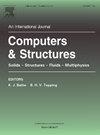制造工艺对弯曲胶合木梁应力状态的影响
IF 4.8
2区 工程技术
Q1 COMPUTER SCIENCE, INTERDISCIPLINARY APPLICATIONS
引用次数: 0
摘要
本研究考察了弯曲胶合木材(胶合木)梁在制造过程中的回弹效应和残余应力。除了沿纵轴(X)弯曲外,由于泊松效应,在横向(Z)方向上也发生了杯形变形。这种变形,结合胶凝硬化过程和压力释放,导致在所有三个轴向的残余应力的发展,以及单个板内及其界面的剪切应力。除了众所周知的纵向弹性、板厚和内半径等因素外,研究表明层数(n)和泊松比(νLT)对残余应力的大小有显著影响。然而,除了纵向应力之外,n和νLT的影响以及其他残余应力几乎没有研究,并且在当前的设计标准中没有充分解决。以不同板层的髓点位置作为输入随机变量,对生长环效应进行蒙特卡罗分析。残余应力在径向和切向上均受到较强的影响,其最大值增大,截面内分布更加分散。利用流变木材模型进行了随时间和水分的松弛分析,结果表明温度和相对湿度对松弛有显著影响。本文章由计算机程序翻译,如有差异,请以英文原文为准。
Influence of the manufacturing process on the stress state of curved glulam beams
This study examines the spring-back effect and residual stresses in curved glued-laminated timber (glulam) beams during the manufacturing process. In addition to curving along the longitudinal axis (), a cup-deformation develops in the transverse direction () due to the Poisson’s effect. This deformation, combined with the glue-hardening process and the release of pressure, leads to the development of residual stresses in all three axial directions, as well as shear stresses within individual boards and at their interfaces.
Besides the well-known factors such as longitudinal elasticity, board thickness, and inner radius, the study reveals that the number of layers () and Poisson’s ratio () significantly influence the magnitude of residual stresses. However, aside from longitudinal stresses, the impact of and , as well as other residual stresses, have been scarcely studied and are not adequately addressed in current design standards.
A Monte–Carlo analysis of the growth-ring effect is conducted, taking the pith location of different board layers as the input random variable. Strong influences can be identified on the residual stresses in both radial and tangential directions, with intensified maximum values and more scattered distribution inside the cross-section. The time- and moisture-dependent relaxation analysis using the rheological wood model shows a significant influence of the temperature and relative humidity.
求助全文
通过发布文献求助,成功后即可免费获取论文全文。
去求助
来源期刊

Computers & Structures
工程技术-工程:土木
CiteScore
8.80
自引率
6.40%
发文量
122
审稿时长
33 days
期刊介绍:
Computers & Structures publishes advances in the development and use of computational methods for the solution of problems in engineering and the sciences. The range of appropriate contributions is wide, and includes papers on establishing appropriate mathematical models and their numerical solution in all areas of mechanics. The journal also includes articles that present a substantial review of a field in the topics of the journal.
 求助内容:
求助内容: 应助结果提醒方式:
应助结果提醒方式:


